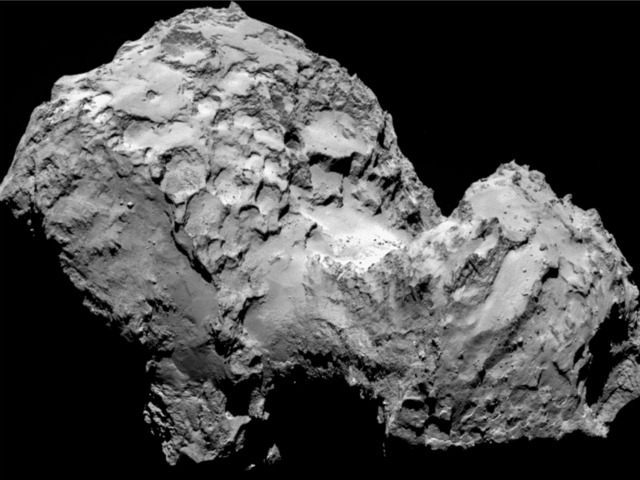Today the Rosetta mission is reporting that oxygen has been found via mass spectrometer on Comet 67P Churyumov-Gerasimenko, the Philae lander’s dumbell shaped target.
The discovery of oxygen is very exciting for scientists who are searching for extraterrestrial life or studying how and where life could theoretically develop in space.
“The first time we saw it, we all went a little bit into denial because molecular oxygen was really not expected to be found on a comet,” Kathrin Altwegg, project leader for ROSINA (Rosetta Orbiter Spectrometer for Ion and Neutral Analysis), told the Los Angeles Times. “It does not sound that spectacular, but it is actually the most surprising discovery we have made so far on 67P.”
The LA Times notes that “molecular oxygen is common on Earth, but it is rarely seen elsewhere in the universe,” having been detected “outside the solar system only twice, and never on a comet.”
Scientists are searching for water, oxygen, and other building blocks of life in order to better understand how life may have formed on our planet, and how and where it may form in the greater universe. Rosetta, the European Space Agency’s (ESA) “Comet Chaser” mission, was approved in November 1993, taking over a decade to prepare and more than a decade of traveling through space to reach the craft’s final destination. Its mission was to study several comets and asteroids, traveling five times the Earth’s distance from the sun and stopping to hibernate for several years at one point. The probe Rosetta is named after the Rosetta Stone, an artifact important to archaeology that helped translate Egyptian script.
This European Space Agency video lays out the fascinating twelve-year voyage of the Philae lander. Launching on March 2, 2004 from the Guiana Space Centre in French Guiana, Rosetta swooped around the sun, then, using inertia from the Earth’s gravity. in 2005 it flung itself into the deeper solar system. It made another full orbit of the sun, then in 2007 got a second and third gravity assist from Mars, then Earth again, with each revolution changing its speed and orbit slightly. During this time it performed flybys on other asteroids like Steins in 2008 and Luteria in 2010. It was then flung out into deep space (far from the sun) and entered a period of hibernation in 2011, waking up in January of 2014 to make its final approach towards its target destination.
A controversy erupted over media reports on a “sexist” shirt worn by Rosetta scientist Matt Taylor, temporarily eclipsing the vastly more interesting story that despite a small technical issue (the spacecraft’s harpoons and ice screws failed) a man-made ship had survived 12 years in space and multiple orbits of the sun to successfully land on a moving comet.
What is particularly interesting about this new discovery is not that just trace amounts of oxygen were found, but more significant amounts than expected. “It is not only that we have oxygen, we have a lot of oxygen,” Altwegg explained. The Rosetta team also conducted tests to confirm the readings they’d received were not the result of faulty equipment.
I’ve been following the Rosetta mission since the started ESA releasing mission explanations and updates regularly on their YouTube channel, and I’m eager to see what they find next.
We at Breitbart wish the Rosetta mission team the best of luck, whatever clothes they wear.
Follow Will Ross on Twitter @SawmillLoris.

COMMENTS
Please let us know if you're having issues with commenting.